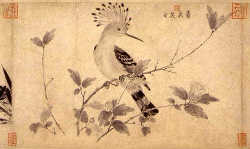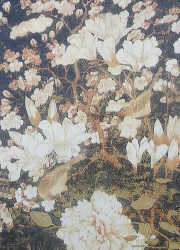Flowers and birds were favorite subjects in paintings in ancient China, offering a kind of special aesthetic interest. As an independent school of paintings, flower-and-bird works originated in the Tang Dynasty (618-907) and matured at the end of the Tang and Five Dynasties period. Many celebrated painters emerged at the time, with Huang Quan and Xu Xi as the representative figures among them.
 |
| A painting by Huang Quan |
Huang was a court painter of the Five Dynasties and most of his works were of rare flowers and birds in courts. The depicted birds in his paintings were full-fledged and flowers looked luxurious under the bush.Sketch of Rare Bird Scroll-- a piece handed down from Huang -- vividly depicts many kinds of birds. Xu lived during the Five Dynasties, too, and was never involved in politics. Xu did not seek fame or wealth -- he just concentrated on painting. Xu used thick strokes and ink, drew branches and leaves plainly, and used a slight hint of color so it would not impair the ink. His works were full of wild interest.Snow Covers Bamboowas one of Xu's works that was handed down in history. Huang and Xu represented completely different styles of painting, and people of later generations named them "Luxurious Huang Quan" and "Quiescent Xu Xi". Both artists later exerted a great influence on the creation of flower-and-bird paintings.
 |
| A painting by Zhao Ji |
 |
| A painting by Xu Xi |
The literati in ancient China were fond of calyx canthus and bamboo paintings, which, to them, were tasteful and unstrained. Such paintings symbolized literati unconventionality. Although calyx canthus and bamboo were part of flower-and-bird paintings, after the Song and Yuan dynasties, when the number of artists increased by the day, the subjects broke away from flower-and-bird painting to become a school of their own. During the Song and Yuan dynasties, Wen Tong, Yang Wujiu, Li Yan, Wang Mian and others were all painters famous for drawing calyx canthus and bamboo. Because of the introduction of theStories of Scholars, Wang became familiar to every Chinese person. In fact, Wang's achievements in painting were not the lotus, which was mentioned in theStories of Scholars, but his calyx canthus and bamboo works.
"Not for the praise of good looks, but for spreading freshness: "From these two lines of a poem, we can plainly see why the painter chose the calyx canthus as his subject -- to express feeling. Zheng Banqiao declined the honor as local official but lived by selling paintings in Yangzhou. He was good at painting orchids, bamboo, calyx canthus and stones. Both his handwriting and painting had a unique style: "I drew orchid, bamboo and stone to console the working people but not to seek pleasure," said Zheng, which also suggested that the calyx canthus and bamboo under his brush contained an exceptional thought state.










